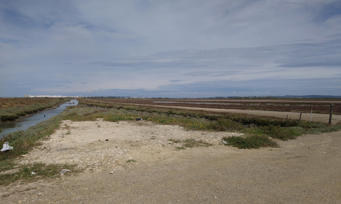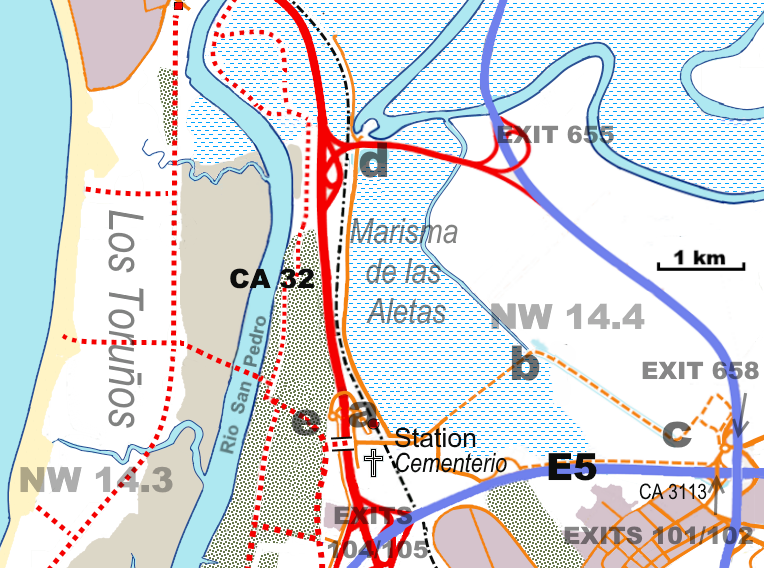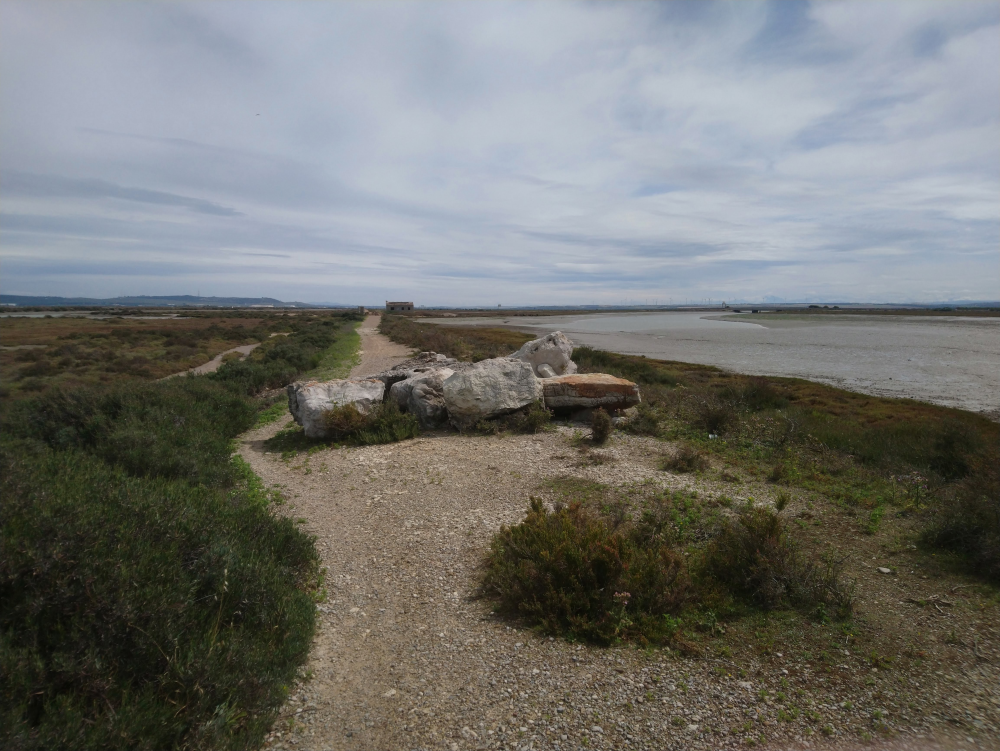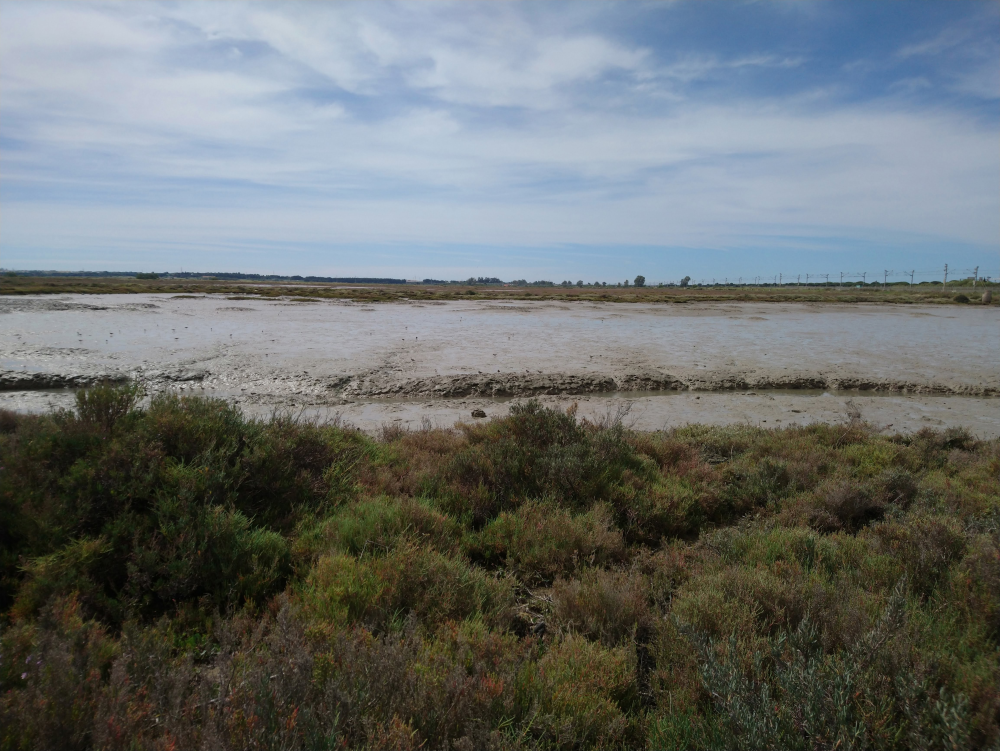 A view across the marisma from (b)
A view across the marisma from (b) |
With over 80 sites detailed in my birding notes it’s always been hard to keep them all up to date. The need for revision has been made all the more acute by my inability to visit the area in the last few years. This is one reason that I ask users for updates but there’s no substitute for actually having a look for myself. Accordingly, when I was out in the area for a month this April visiting several sites that I was fairly sure needed a thorough revision was a priority.  A view across the marisma from (b) A view across the marisma from (b) Amongst these was one of the few localities, Marisma de las Aletas (NW 14.4) that I had added to my notes without actually visiting at all but solely on the strength of information culled from Ebird (https://ebird.org/hotspot/L5561089). Not that there was much information to be found even in that admirable source. When I added it there were just 3 checklists featuring a meagre 45 species (this has since increased to six checklists and 86 species – not including my own which I will add anon). Four factors made me break my usual rules and add the site. First that it looked an easy way to access the vast and sprawling salinas of the Bahia de Cadiz. Second that it wasn’t too far from a trio of sites (Laguna de Medina, Lagunas del Puerto Santa Maria and Lagunas de Chiclana are all within 20 minutes) that are good for birds of freshwater wetlands so would allow visitors to add a set of additional species without too much effort or a long drive. Third that amongst the featured species was one that many visitors are keen to see, Lesser Short-toed Lark. Finally, and somewhat surprisingly, it was also had a railway station making it convenient for those without a car. The Marisma de las Aletas was the second of three novel sites (which I will cover in further posts) that I visited this spring. As I had already visited Laguna de Medina in the morning it was already rather too warm when I checked out las Aletas so the birds had largely stopped singing. It was gratifying to discover that the assumptions I’d made proved to be correct. It was quick to get there from Laguna Medina and, the habitat, largely mud flats and salinas, promised a different range of species. The station car park (a) is huge and, on my visit at least, hardly used. Driving over the bridge over the railway line I first continued straight on to check the open salt marsh/salinas (b). Whilst the habitat look perfect for my target species (Lesser Short-toed Lark) being the middle of the day I struggled to find any larks whatsoever – only poor flight views of Crested/Thekla’s and a brief snatch of song that I tentatively identified as (Greater) Short-toed Lark. The habitat certainly looked excellent for both short-toed species. The track was in good condition at least until (c) where I turned back to the station. Reaching the tarmac road again this time I headed north towards (d). The muddy margins here were good, if not spectacularly so, for wading birds (Redshank, Curlew Sandpiper, Dunlin, Grey & Kentish Plover, etc) plus the ubiquitous Black-winged Stilt on roadside pools. (In hindsight I should have continued further along this road to checkout distant gulls as Slender-billed has also been reported here). So there was plenty here to quickly bump up your wader list after visiting somewhere like the Laguna de Medina. Returning back along the road I had a stroke of good fortune when a Great-spotted Cuckoo flew overhead closely pursued by a Magpie. I’ve found the former species to be very elusive in the area so this was a great bonus. Cadiz’s bird atlas (published c1990) calls it a “A very scarce and localised summer visitor in our province. Regular in small numbers during migration” and shows ‘probable breeding’ in only two 10 km squares (both near Trebujena). Yet the loud calls and enthusiastic mobbing of the Magpie, which chased it for a kilometre or more, suggested that the cuckoo may have been doing more than just passing through. It’s tempting to speculate whether the apparently huge increase in the numbers of (Eurasian) Magpies, which in Cadiz province were evidently previously almost entirely restricted to Chipiona, but are now found more widely (esp. the Bahia de Cadiz) may lead to a similar increase in Great-spotted Cuckoo. Tempting but as the cuckoo doesn’t seem to breed in Morocco, where there’s a local race of Magpie, perhaps other environmental factors militate against it breeding regularly or in numbers quite so far south. Returning to the station, I then checked out the new (2018) footbridge that spanned the busy main road (open 07.45 - 22.00). It’s existence is an unexpected bonus as it allows birders to explore the scrub and woodlands here (e), the estuary of the Rio San Pedro and the Los Toroñus peninsula beyond. Heading north takes you to more more salinas (c3 km) and the really energetic could even walk c10 km to the next station (Puerto de Santa Maria). The Marisma de las Aletas may never be a first option stop for visiting birders but for those visiting the vicinity to check the nearby lagunas and wetlands, it certainly represents a good opportunity to add several species to their tally, particularly Lesser Short-toed Lark (and a chance for Thekla’s without heading for nearby mountains). For those using public transport (particularly those with access to a cycle) this could one of the best destinations available to them.
0 Comments
Leave a Reply. |
About me ...Hi I'm John Cantelo. I've been birding seriously since the 1960s when I met up with some like minded folks (all of us are still birding!) at Taunton's School in Southampton. I have lived in Kent , where I taught History and Sociology, since the late 1970s. In that time I've served on the committees of both my local RSPB group and the county ornithological society (KOS). I have also worked as a part-time field teacher for the RSPB at Dungeness. Having retired I now spend as much time as possible in Alcala de los Gazules in SW Spain. When I'm not birding I edit books for the Crossbill Guides series. CategoriesArchives
May 2023
|





 RSS Feed
RSS Feed
